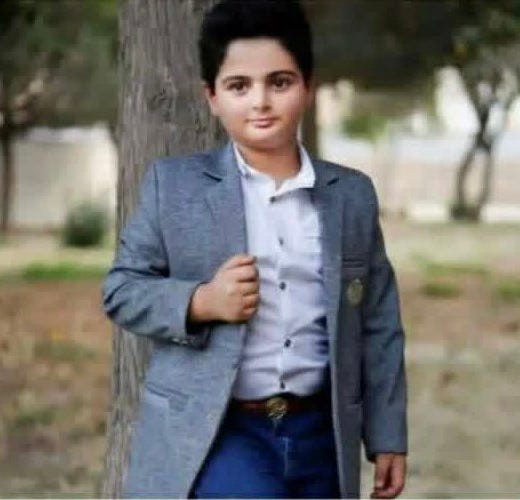Iranian Gov’t Supporters Use Social Media to Deny Killing Nine Year Old
“Rainbow Kian” has become a symbol of the Islamic Republic’s brutality. Government supporters are trying to blame his death on the opposition.
Kian Pirfalak wanted to be an inventor. He made an adorable video showing off one of his science projects. Official announcements in Iran begin “in the name of the Lord,” and Pirfalak began his clip “in the name of the Lord of rainbows,” a reference to a poem from Iranian schoolbooks.
Last week, Pirfalak was gunned down in Izeh, Iran. Paramilitaries opened fire on the family car at a police checkpoint, killing Pirfalak and wounding his father, according to their relatives. The government denies its role and contends that “terrorists” actually shot at the Pirfalak family.
Other better-sourced journalists have covered this tragedy in depth. However, it’s also worth looking at the use of social media to contest Pirfalak’s death. Pro-government campaigns are starting to use gritty “open source intelligence” aesthetics to give themselves a more authentic feel. And their claims have even started to trickle into English-language alternative media.
Kian and his rainbow dreams have become a symbol of the opposition to the Iranian government. Not only have the authorities unleashed brutal violence against their opponents, but innocent bystanders are also being gunned down, even children who dream about inventions and rainbows.
Iranian soccer captain Ehsan Hajsafi declared his support for the protests during the World Cup, beginning his comments with, “in the name of the Lord of rainbows.”
From the beginning, the Iranian government has denied its role in killing Pirfalak and instead blamed armed opposition militants.
The night that Pirfalak was shot, November 16, official media reported that “terrorists” had fired into crowds in Izeh as well as the major city of Esfahan, killing three security personnel. No group has taken responsibility for the alleged attacks.
The government soon incorporated Pirfalak into its messaging, portraying him as a martyr of the Islamic Republic, and even putting up posters of his photo in public places. Someone set fire to one of those posters, which pro-government commentators used as evidence that the opposition hates dead children.
News of the killing spread when Pirfalak’s mother Zeynab Molaie-Rad gave a moving funeral oration, explaining that the family was trying to make a U-turn near a police checkpoint when pro-government militiamen opened fire.
“Listen to me how the shooting happened, so they can’t say it was done by terrorists, because they’re lying,” she said. “Plainclothes forces shot my child.”
The funeralgoers chanted for the downfall of Supreme Leader Ali Khamanei.
Masih Alinejad, anchor for the U.S. government channel Voice of America, translated the speech in full:
Hojjatollah Darvishpur, former member of parliament for Izeh, also said on state TV that “the same ones who shot up the car took Kian and his father to the Red Crescent [hospital].”
Soon after the shooting, an Iranian government news outlet published an alleged online communiqué from ISIS taking responsibility for the attack, but then took it down after the BBC pointed out that the “ISIS claim” had glaring grammatical mistakes in Arabic.
It’s unclear whether the fake ISIS claim was concocted by the government itself, or was picked up from an unreliable source.
A paramilitary officer gave an interview to state TV from a hospital bed, claiming he had come under fire in Izeh and did not have the weapons to defend himself.
As outrage grew, Molaie-Rad was brought in front of the cameras to take back her comments. The Iranian government has previously forced the families of people killed by police to make statements under duress.
But another element of the denial campaign was new. It played to the hunger for viral content on social media and the tendency to believe grainy amateur footage from “OSINT” analysts over mainstream news sources.
State news outlets published bodycam footage from a police checkpoint in Izeh. In the video, officers try to turn back cars while gunfire goes off in the background. They complain that they were sent into a dangerous situation without military equipment.
There is no real indication of when the video was filmed. Its dialogue is straight out of the “copaganda” playbook.
Social media accounts also spread undated security camera footage showing youths with rifles driving around Izeh on motorcycles.
Esmail Manavi, a pro-government commentator from the region, used geolocation to “prove” that rebel gunmen had fired on the Pirfalak family car from opposite the checkpoint. But again, it’s not established that the footage he cited was filmed on the night of Pirfalak’s death.
Some pro-government accounts even scrutinized Molaie-Rad’s Instagram account, poring through the pages she follows to prove that she had been brainwashed by the opposition. It is worth mentioning the existence of this narrative, but I will not be reposting any examples of smears against a bereaved mother.
The pro-government campaign has entered English-language media. The Cradle published an article about the “war of narratives” around Pirfalak’s killing. The article portrays the bodycam footage as conclusive proof of the government’s story, and pushes the conspiracy theory that the shooting was “an operation – one of many, lately – being waged by opposition gunmen to blame both the government and its forces for the death of Iranian civilians.”
One more thing is worth noting.
When reports first emerged of a “terrorist attack” in Izeh, several prominent pro-opposition commentators actually celebrated the shooting, cheering on the idea that the “people” were killing “regime mercenaries.” It follows a broader trend of popular anonymous accounts or activists outside the country calling for violent revenge against the Iranian police and military.
As it turns out, the violence was the shooting of a family at a police checkpoint.
None of the social media links should be taken as an endorsement of the accounts in question.





